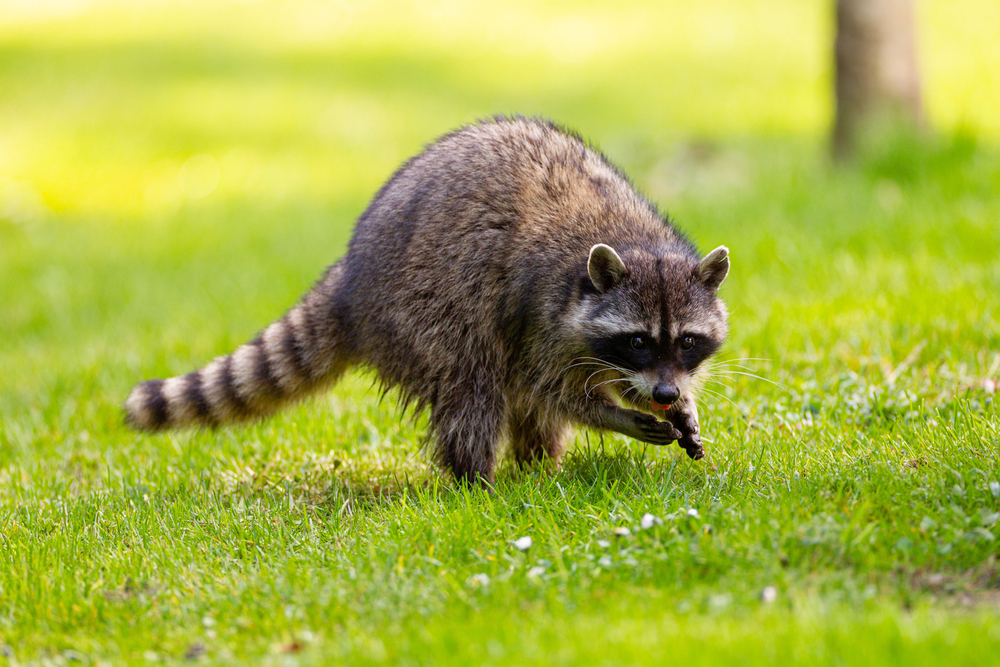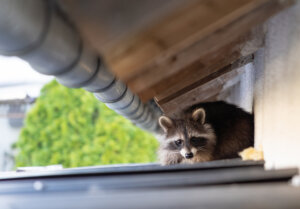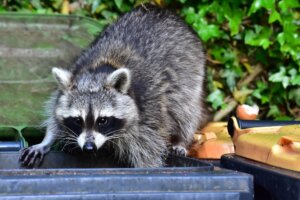Raccoons are smarter than the average pest, and their little hands can make a lot of mess for us humans. Whether they’re making your house their home or helping themselves to your garbage for dinner, one thing’s for sure, they’ve got to go. Follow these tips to ensure your home doesn’t look too inviting to a family of raccoons or other animals and learn how to prevent them from doing any further damage.
Signs You’ve Got Raccoons
Besides actually seeing a raccoon or other animal on your property or in your home, there are some subtle signs they’ve arrived. Knowing the signs will help you better assess the situation and figure out if it’s raccoons you have or another pest.
- Most raccoon damage will be found in the attic as this is where they like to make dens.
- Look out for damage to your eavestroughs and gutters, this could indicate a raccoon is using them to climb into your home.
- Torn roof shingles near vents could be a sign of entry.
- Droppings in a central location on the roof or inside the attic are sure signs of raccoons.
- Check to see if your attic insulation or wiring has been chewed or torn apart. Raccoons are not picky when it comes to their diet and will eat almost anything.
- Listen for rustling or cooing in the walls. There could be a baby raccoon hiding between studs.
Preventative Raccoon Measures
The best way to prevent a family of raccoons from moving in is to make your home as uninviting as possible for them. Racoons don’t want to live in your home, but if it looks like a more appealing place to raise their young, or if there’s easy access to food, they might consider making the move. Try these tips to keep them away.
No Food In Sight
While you may not think much about your garbage after putting it on the curb on garbage day, this is the day raccoons wait all week for. Raccoons love garbage. They love picking through it, eating it, and then throwing it across your front lawn. To ensure this doesn’t happen, be sure your garbage is not easily accessible. Many homeowners have built raccoon proof shelters for their garbage cans. Not only will this help keep pests away, it’s an attractive way to store your bins.
If building an enclosure is not an option for you, make sure your garbage bin has a thick lid and has something on top of it to keep it closed. Thin lids can easily be chewed through and many raccoons are smart enough to figure out tricky locking systems. Take a look at your local hardware store to see if they sell garbage cans made especially for raccoons.
Raccoons will also eat food you put out for other animals. If you have bird or squirrel feeders, consider bringing them in at night. Or install baffles on them to prevent raccoons from climbing up them. If you leave cat or dog food outside overnight, consider stopping this. Not only will it attract local raccoons, but skunks, mice and rats could show up too!
Landscaping Matters
As we’ve mentioned, raccoons are smart and they’re always coming up with new ways to make their surroundings work for them. Raccoons can easily climb trees, so make sure your trees are not close enough to your house that a raccoon could use it as a ladder and jump right on to your roof. Experts recommend keeping your trees trimmed back 6 to 8 feet away from your home.
If you’re concerned about raccoons climbing up the side of your home and getting in that way, there’s a solution for that. Metal flashing can be installed on wooden beams or on the corners of your home to prevent raccoons climbing up. You can also install motion lights on the side of your home that will stop raccoons in their tracks.
While raccoons have a palate for garbage, they will gladly eat out of your garden as well. To stop them from doing this, try sprinkling a variety of herbs and spices, such as cayenne pepper, garlic, and chilli flakes in your garden bed to help keep raccoons and other critters away.
Call in the Pros – Pest and Animal Control
If your home is already inhabited by a family of raccoons, you’ll need to hire a professional pest and animal control specialist to remove them. While raccoons may be cute, you have to remember these are wild animals who will not respond the same way as your cat or dog would to you trying to pick them up. Do not try to remove them on your own.
A pest and animal control specialist can do more than just remove the pests in your home. They can also:
- Inspect your home for entry points and signs of damage.
- Fix damage and problem areas so pests cannot use them as entry points.
- Clean and deodorize smells left behind from pests.
- And finally, trap and remove your unwanted houseguests.
Below are the average costs of Pest & Animal Control services across different cities in Canada:
| City | Average | Minimum | Maximum |
| Barrie | $382 | $100 | $25,000 |
| Calgary | $825 | $100 | $8,250 |
| Edmonton | $879 | $175 | $1,550 |
| Hamilton | $1,042 | $100 | $30,000 |
| Oshawa | $350 | $200 | $500 |
| Ottawa | $695 | $100 | $50,000 |
| Toronto | $617 | $100 | $50,000 |
| Vancouver | $414 | $100 | $22,500 |
*Costs based on 9231 verified Canadian homeowner reviews as of March 2022
If you’re ready to take back your home from raccoons, hire a pest control specialist who can ethically and safely remove your pest problem. Click here to easily submit a service request and be connected to local pest and animal control specialists in your area.
Article Updated June 2022.



